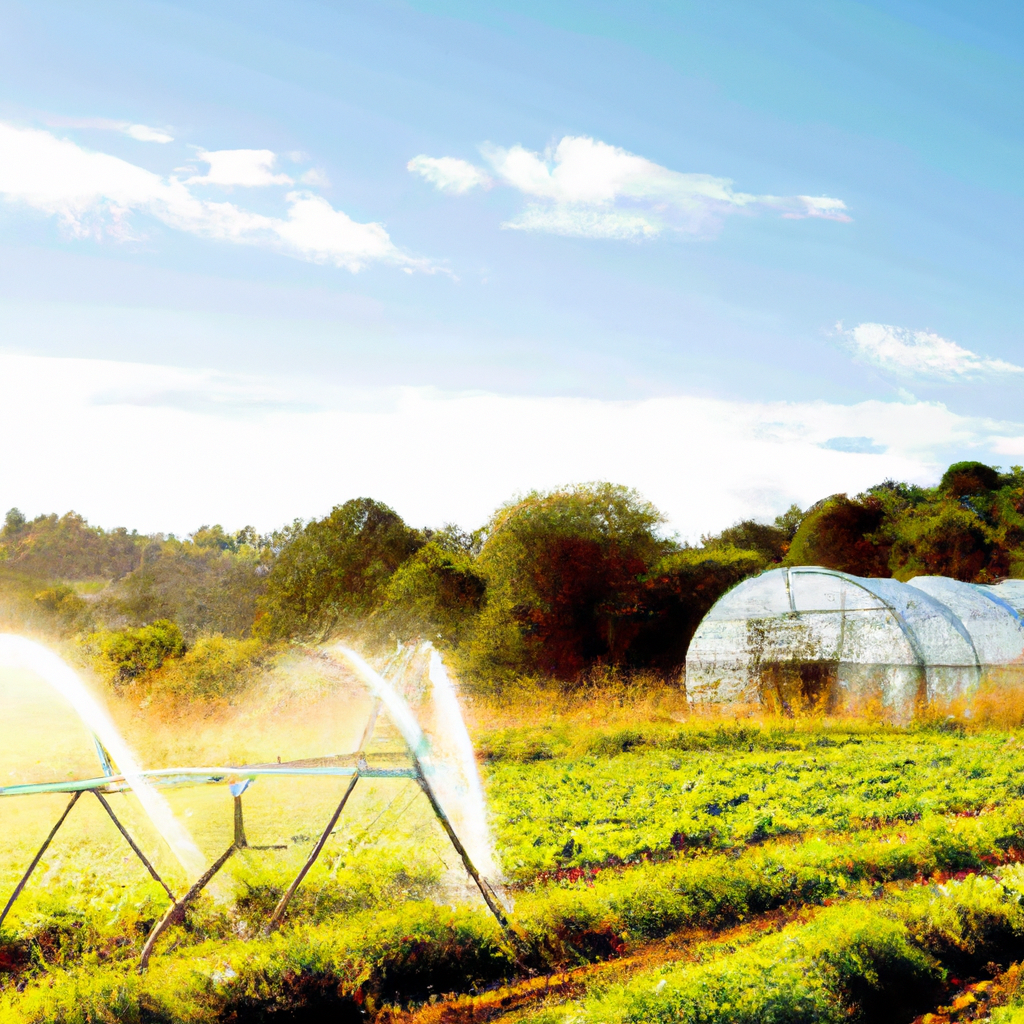Imagine a world where crops thrive without the need for harmful pesticides, where water is used efficiently, and where agricultural practices are sustainable for generations to come. Welcome to the Green Revolution 2.0, a time of groundbreaking advancements in sustainable agriculture technology. In this article, we will explore how technology is shaping the future of farming, from precision farming techniques to innovative solutions that tackle the challenges of climate change. Get ready to be inspired by the incredible progress being made to ensure a greener and more sustainable future for our planet.
Importance of Sustainable Agriculture
Environmental Benefits
Sustainable agriculture plays a crucial role in preserving our environment for future generations. By adopting sustainable farming practices, we can minimize the negative impacts on ecosystems and natural resources. This includes reducing pollution from chemical fertilizers and pesticides, conserving water, and preserving soil quality. By promoting biodiversity on farms, sustainable agriculture also helps to protect and restore habitats for various species.
Economic Benefits
Sustainable agriculture offers numerous economic benefits. By employing innovative techniques and practices, farmers can increase productivity while minimizing input costs. This leads to improved yields and profitability. Additionally, sustainable farming practices reduce reliance on expensive chemical inputs, which can result in significant cost savings for farmers. Moreover, sustainable agriculture fosters local economies by creating job opportunities in the agricultural sector and supporting the growth of rural communities.
Food Security
In a world where the global population is continuously increasing, ensuring food security is of paramount importance. Sustainable agriculture contributes to food security by enhancing the resilience and productivity of agricultural systems. By employing practices that conserve soil fertility, optimize water usage, and promote sustainable crop production, farmers can produce a higher quantity and quality of food. Moreover, sustainable agriculture encourages the diversification of crops, reducing the vulnerability of food systems to pests, diseases, and climate-related challenges.
Health Benefits
Sustainable agriculture also has significant health benefits. By reducing the use of synthetic chemicals, sustainable farming practices offer a safer and healthier food production system. These practices minimize the risk of chemical residues in food, ensuring that consumers are provided with nutritious and toxin-free produce. Additionally, sustainable agriculture promotes the use of organic farming methods, which enhance soil fertility and improve the nutritional quality of crops. This translates to more wholesome and nutrient-rich food options for consumers.
Evolution of Sustainable Agriculture
Green Revolution 1.0
The Green Revolution 1.0, which began in the mid-20th century, marked the advent of modern agricultural practices aimed at increasing crop yields. It involved the introduction of high-yielding crop varieties, the use of synthetic fertilizers and pesticides, and the mechanization of farming processes. While the Green Revolution 1.0 succeeded in increasing agricultural productivity, it also led to unintended negative consequences such as environmental degradation, soil erosion, and water pollution.
Need for Green Revolution 2.0
With the realization of the ecological and socio-economic impacts of unsustainable farming practices, there is a need for a second wave of the Green Revolution. Termed Green Revolution 2.0, this approach seeks to combine technological advancements with sustainable agriculture practices. The focus is on maximizing productivity while minimizing negative environmental impacts. Green Revolution 2.0 aims to harness the power of innovation and technology to create a more sustainable and resilient agricultural sector.

Key Challenges
Water Scarcity
Water scarcity is one of the most significant challenges faced by agriculture. With the global water crisis intensifying, sustainable agriculture aims to optimize water usage through efficient irrigation techniques, such as drip irrigation and precision agriculture. By implementing water conservation practices, such as rainwater harvesting and water recycling systems, farmers can ensure the sustainable use of this vital resource.
Soil Degradation
Soil degradation poses a severe threat to agricultural productivity. Unsustainable farming practices, including excessive use of chemical inputs, improper tillage techniques, and monocropping, deplete soil fertility and degrade its physical structure. Sustainable agriculture promotes practices such as organic farming, agroforestry, and crop rotation, which help restore soil health, prevent erosion, and enhance nutrient cycling, ensuring long-term sustainability of the land.
Climate Change
Climate change is increasingly manifesting its impact on agriculture through extreme weather events, changing rainfall patterns, rising temperatures, and the spread of pests and diseases. Sustainable agriculture aims to enhance resilience to climate change through practices such as conservation agriculture, which involves minimal soil disturbance and the use of cover crops. Additionally, the adoption of climate-resistant crop varieties helps farmers mitigate the risks associated with unpredictable climatic conditions.
Loss of Biodiversity
Intensive agricultural practices have contributed to the loss of biodiversity, as vast areas of natural habitats have been converted into farmland. Sustainable agriculture promotes the conservation of biodiversity by creating and maintaining habitats for native species on agricultural land. This includes planting hedgerows, adopting agroforestry practices, and preserving natural areas within farms. By fostering biodiversity, sustainable agriculture helps maintain crucial ecosystem services and enhances the overall sustainability of agricultural systems.
Technological Advancements
Precision Agriculture
Precision agriculture, also known as smart farming, utilizes technologies such as GPS, sensors, and drones to monitor and manage farming practices with precision. This approach helps optimize the use of resources by providing real-time data on soil conditions, crop health, and weather patterns. By enabling targeted application of inputs such as water, fertilizers, and pesticides, precision agriculture minimizes waste, improves efficiency, and reduces environmental impacts.
Vertical Farming
Vertical farming involves the cultivation of plants in vertically stacked layers, utilizing controlled environments such as indoor facilities and hydroponic or aeroponic systems. By maximizing land use and eliminating the need for traditional soil-based agriculture, vertical farming enables year-round production of crops in urban areas and regions with limited arable land. This technology minimizes water usage and prevents soil degradation while reducing the energy required for transportation and storage.
Aquaponics
Aquaponics is a sustainable farming technique that combines hydroponics with aquaculture. It involves growing plants and cultivating fish in a symbiotic system, where fish waste provides nutrients for the plants, and the plants filter the water for the fish. Aquaponics reduces water consumption compared to traditional soil-based farming, eliminates the need for chemical fertilizers, and enables the production of both crops and fish in a single integrated system, maximizing resource efficiency.
Hydroponics
Hydroponics is a soilless farming technique that involves growing plants in nutrient-rich water solutions, with the necessary minerals provided directly to the roots. By eliminating the need for soil, hydroponics offers various advantages, including precise control of nutrient levels, reduced water consumption, and faster growth rates. This technology allows the cultivation of crops in environments where traditional agriculture is challenging, such as arid regions or urban areas with limited space.
AI and Machine Learning
Artificial intelligence (AI) and machine learning are revolutionizing agriculture by enabling data-driven decision-making and automation. AI-powered systems can analyze vast amounts of data, including weather patterns, soil conditions, and crop health, to provide valuable insights and predictive models. Machine learning algorithms can optimize irrigation scheduling, detect plant diseases, and manage pest control. These technologies enhance productivity, reduce resource wastage, and support farmers in making informed and precise decisions.
Big Data Analytics
The collection and analysis of large amounts of agricultural data contribute to improving efficiency and sustainability. Big data analytics help identify patterns, optimize resource allocation, and predict crop yields. By integrating data from various sources, such as satellite imagery, weather conditions, and market trends, farmers can make data-driven decisions regarding planting, fertilizing, and harvesting. These insights improve the overall management of agricultural systems and enable farmers to respond effectively to challenges.
Robotics and Drones
Robotics and drones are being increasingly utilized in agriculture for various tasks such as planting, harvesting, and crop monitoring. These technologies offer precision and efficiency, reducing labor costs and minimizing the use of chemical inputs through targeted application. Drones equipped with sensors and cameras can provide real-time data on crop health, detect pest infestations, and monitor crop growth. Robotics and drones streamline farming operations, enhance productivity, and contribute to sustainable agricultural practices.

Sustainable Crop Production
Organic Farming
Organic farming is a sustainable agricultural practice that relies on natural methods and materials rather than synthetic inputs. It emphasizes soil fertility, crop rotation, and the use of organic fertilizers and pesticides. Organic farming aims to maintain ecosystem health, preserve soil quality, and produce nutritious and safe food. By avoiding the use of synthetic chemicals, organic farming offers environmental benefits and improves the biodiversity of agroecosystems.
Regenerative Agriculture
Regenerative agriculture is an approach that goes beyond sustainability, focusing on restoring and improving ecosystem health. It emphasizes practices such as cover cropping, minimal tillage, and crop diversity to enhance soil health, sequester carbon, and promote biodiversity. Regenerative agriculture aims to create farming systems that support soil regeneration, water conservation, and enhanced ecological resilience, resulting in sustainable crop production and long-term land productivity.
Agroforestry
Agroforestry integrates trees with crops or livestock in agricultural systems, harnessing the benefits of combining agriculture and forestry. Agroforestry practices include alley cropping, where rows of trees are intercropped with crops, and silvopasture, where trees are integrated into livestock grazing areas. Agroforestry enhances biodiversity, improves soil fertility, conserves water, and provides additional income streams for farmers. This practice promotes sustainable crop production while contributing to climate change mitigation and adaptation.
Crop Rotation
Crop rotation involves the sequential planting of different crops on the same piece of land over multiple growing seasons. It helps break disease and pest cycles, reduces soil erosion, and enhances soil fertility by varying the nutrient demands of different crops. Crop rotation also promotes weed control and reduces the need for synthetic herbicides. This sustainable practice improves soil health, prevents nutrient depletion, and contributes to sustainable crop production.
Cover Crops
Cover crops are non-commercial crops planted during fallow periods or between cash crops to cover and protect the soil. They provide various benefits, including soil erosion prevention, nutrient retention, weed suppression, and improved soil structure. Cover crops also enhance biodiversity by providing habitat for beneficial insects and microorganisms. This sustainable practice supports soil health, conserves water, and reduces the reliance on synthetic inputs.
Efficient Resource Management
Water Conservation
Efficient water management is crucial for sustainable agriculture, especially in regions facing water scarcity. Farmers can adopt various water conservation practices such as drip irrigation, which targets water directly to plant roots, reducing water wastage. Other techniques include mulching, which helps retain soil moisture, and rainwater harvesting systems to capture and store precipitation for irrigation purposes. By optimizing water usage, farmers can ensure water availability for future generations and mitigate the impacts of droughts and water scarcity.
Soil Health Management
Maintaining soil health is essential for sustainable agriculture. Soil health management involves practices such as minimal tillage, organic matter incorporation, and the use of compost or manure to enhance soil fertility and structure. Additionally, soil testing and nutrient management plans help optimize nutrient application, minimizing the risk of overuse or leaching. By prioritizing soil health, farmers can ensure the long-term productivity and sustainability of their agricultural systems.
Nutrient Management
Proper nutrient management is crucial to avoid nutrient imbalance, water pollution, and excessive fertilizer use. Farmers can implement practices such as precision fertilization, where nutrients are applied based on crop needs and soil analysis. This reduces nutrient losses and minimizes environmental impacts. Additionally, the use of organic fertilizers and compost promotes sustainable nutrient cycling and improves soil fertility. Nutrient management practices aid in sustainable crop production while protecting water quality and minimizing nutrient runoff.
Pest and Disease Control
Integrated pest management (IPM) is a sustainable approach to pest and disease control that combines various techniques to minimize reliance on synthetic pesticides. IPM strategies include biological controls, such as the introduction of natural predators, the use of pheromones for pest monitoring, and cultural practices like crop rotation and trap cropping. A holistic approach to pest and disease control reduces chemical inputs, minimizes the development of resistance in pests, and supports the natural balance of beneficial organisms.

Climate-Smart Agriculture
Carbon Farming
Carbon farming aims to sequester atmospheric carbon dioxide (CO2) in agricultural soils, reducing greenhouse gas emissions and mitigating climate change. Practices such as no-till farming, cover cropping, and agroforestry enhance carbon storage in the soil. Additionally, the use of organic farming practices and incorporation of biochar can further contribute to carbon sequestration. Carbon farming not only helps combat climate change but also improves soil health and resilience to extreme weather events.
Climate-Resistant Crop Varieties
As climate change alters growing conditions, breeding and adopting climate-resistant crop varieties become essential. Climate-resistant crop varieties are developed to tolerate extreme temperatures, drought, flooding, and pests or diseases associated with climate change. By cultivating resilient crop varieties, farmers can reduce crop losses, ensure food security, and adapt to changing climatic conditions. Furthermore, optimizing crop genetic diversity contributes to a more robust and adaptable agricultural system.
Conservation Agriculture
Conservation agriculture is a sustainable farming system that involves minimal soil disturbance, permanent soil cover, and crop rotation. This method improves soil health, reduces erosion, and enhances water retention. Conservation agriculture helps combat climate change by sequestering carbon in the soil and reducing greenhouse gas emissions associated with tillage. By implementing conservation agriculture practices, farmers contribute to sustainable crop production and adapt to climate change impacts.
Drought and Flood Management
With climate change leading to more frequent and intense droughts and floods, managing these extremities is crucial for sustainable agriculture. Techniques such as water storage and irrigation infrastructure, flood control measures, and precision water management systems help farmers adapt to water-related challenges. By investing in water management systems and implementing climate-resilient practices, farmers can mitigate the impacts of droughts and floods, ensuring the continuity of agricultural production.
Enhancing Agricultural Productivity
Genetic Engineering
Genetic engineering is a technology that involves manipulating an organism’s genetic material to introduce desirable traits, such as disease resistance or increased yield. By modifying crops at the genetic level, scientists can enhance productivity and improve plant traits. Genetic engineering offers opportunities for crop improvement, including nutrient fortification, tolerance to extreme weather conditions, and increased pest and disease resistance. These advancements contribute to sustainable agricultural productivity and food security.
Biotechnology
Biotechnology encompasses various techniques used to enhance agricultural productivity and sustainability. Biotechnological tools, such as tissue culture, genetic markers, and gene editing, facilitate the development of improved crop varieties with desired traits. Biotechnology also plays a role in the production of biofuels, biodegradable plastics, and bio-based products, contributing to a more sustainable agricultural sector. By harnessing the potential of biotechnology, farmers can enhance crop quality, yield, and resistance to environmental stresses.
Seed Technology
Seed technology encompasses various advancements in seed production, processing, and quality control. Through seed technology, farmers gain access to improved seed varieties with higher yields, enhanced disease resistance, and improved nutrition. Seed treatments, including seed coatings and bio-priming, promote early plant vigor, disease suppression, and nutrient uptake. By adopting seed technology, farmers can optimize crop performance, increase productivity, and reduce environmental impacts associated with seed production and usage.
Crop Breeding
Crop breeding is an essential component of enhancing agricultural productivity. Through traditional breeding techniques or modern approaches such as marker-assisted breeding, scientists develop new crop varieties with improved traits. Breeding programs focus on enhancing yield potential, disease resistance, drought tolerance, and nutritional value. Crop breeding contributes to the development of climate-resilient varieties, addressing the challenges posed by climate change and ensuring sustainable crop production for future generations.

Digital Solutions for Agriculture
Farm Management Systems
Farm management systems integrate various digital tools and software to effectively manage farm operations. These systems facilitate farm planning, record-keeping, and decision-making processes. They enable farmers to monitor crop growth, track inputs, analyze data, and optimize resource allocation. Farm management systems aid in improving efficiency, reducing waste, and enhancing overall farm productivity.
Internet of Things (IoT)
The Internet of Things (IoT) technology helps connect agricultural devices and sensors to collect and exchange data in real-time. IoT enables remote monitoring of crop conditions, soil moisture levels, and environmental factors. This data-driven approach allows farmers to make informed decisions regarding irrigation, fertilization, and pest control. By harnessing IoT, farmers can optimize resource usage, detect problems at an early stage, and maximize crop yields.
Remote Sensing
Remote sensing involves the use of satellites, aerial drones, or other platforms to collect data about the Earth’s surface. In agriculture, remote sensing provides valuable information on crop health, soil moisture, and vegetation indices. This data assists farmers in identifying areas of stress, optimizing irrigation, and managing crops more effectively. Remote sensing technology improves efficiency, reduces input costs, and supports sustainable agricultural practices.
Blockchain in Supply Chain
Blockchain technology offers transparency and traceability in the agricultural supply chain. By recording and securely sharing transactional data, blockchain ensures that information regarding the origin, quality, and handling of agricultural products is readily available. Blockchain can help prevent fraud, ensure fair trade, and reduce the environmental impact of supply chains. This technology fosters trust and accountability, promoting sustainable agricultural practices and enhancing market access for farmers.
Key Players in Sustainable Agriculture Tech
AgTech Startups
AgTech startups play a vital role in driving innovation and technological advancements in sustainable agriculture. These companies focus on developing and implementing cutting-edge solutions, such as precision farming technologies, digital platforms, and biotechnological tools. AgTech startups contribute to the transformation of the agricultural sector by providing farmers with access to state-of-the-art technologies, improving farm efficiency, and promoting sustainable practices.
Government Initiatives
Government initiatives are instrumental in promoting sustainable agriculture and supporting the adoption of agricultural technologies. Governments invest in research and development, provide financial incentives, and establish regulations that encourage sustainable farming practices. Additionally, governments often collaborate with stakeholders, including farmers, researchers, and technology providers, to facilitate knowledge sharing and technology transfer. Government initiatives play a crucial role in fostering the growth of sustainable agriculture tech and ensuring its widespread adoption.
Multinational Corporations
Multinational corporations (MNCs) play a significant role in driving sustainable agriculture tech forward. Many of these corporations develop and invest in technologies that enhance agricultural productivity, resource efficiency, and environmental sustainability. MNCs often collaborate with farmers, researchers, and startups to develop and implement innovative solutions. Their investment and expertise in sustainable agriculture tech contribute to the advancement and dissemination of cutting-edge technologies throughout the agricultural sector.













